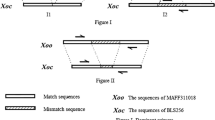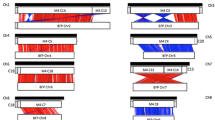Abstract
Pantoea stewartii subsp. stewartii (Pnss) and P. stewartii subsp. indologenes (Pnsi) are closely related plant pathogens that differ in their host specificities. Pnss is the causal agent of Stewart’s wilt of corn, whereas Pnsi causes disease on millets but not corn. Comparative genomics is a valuable method for characterizing the differences between genomes, but there are few studies on this important quarantine pathogen. Here, we compared publicly available genomes of seven strains of Pnss and three strains of Pnsi. Pan- and core-genome analyses showed that strains isolated from close geographical regions are more similar in their genome structures. Gene content and collinearity analyses further revealed numerous strain-specific genes. In particular, the Pnss type strain DC283 contained over 1200 additional genes compared with other strains. Importantly, we also identified eleven genes that are only present in Pnsi genomes and thus may be useful to distinguish between Pnss and Pnsi strains. Overall, this study characterized the common and distinct genomic features of Pnss and Pnsi, which lay the foundation for future development of molecular methods to detect the Stewart’s wilt pathogen in maize for quarantine regulations and distinguish its two subspecies.



Similar content being viewed by others
References
Addy HS, Askora A, Kawasaki T, Fujie M, Yamada T (2012a) The filamentous phage φRSS1 enhances virulence of Phytopathogenic Ralstonia solanacearum on tomato. Phytopathology 102:244–251
Addy HS, Askora A, Kawasaki T, Fujie M, Yamada T (2012b) Loss of virulence of the Phytopathogen Ralstonia solanacearum through infection by φRSM filamentous phages. Phytopathology 102:469–477
Braun EJ (1982) Ultrastructural investigation of resistant and susceptible maize inbreds infected with Erwinia stewartii. Phytopathology 72:159–166
Chen F, Mackey AJ, Stoeckert CJ Jr, Roos DS (2006) OrthoMCL-DB: querying a comprehensive multi-species collection of ortholog groups. Nucleic Acids Res 34:D363–D368
Comandatore F, Sassera D, Montagna M, Kumar S, Koutsovoulos G, Thomas G, Repton C, Babayan SA, Gray N, Cordaux R, Darby A, Makepeace B, Blaxter M (2013) Phylogenomics and analysis of shared genes suggest a single transition to mutualism in Wolbachia of nematodes. Genome Biol Evol 5:1668–1674
Coplin DL, Majerczak DR, Zhang YX, Kim WS, Jock S, Geider K (2002) Identification of Pantoea stewartii subsp. stewartii by PCR and strain differentiation by PFGE. Plant Dis 86:304–311
Coutinho TA, Venter SN (2009) Pantoea ananatis: an unconventional plant pathogen. Mol Plant Pathol 10:325–335
Darling ACE, Mau B, Blattner FR, Perna NT (2004) Mauve: multiple alignment of conserved genomic sequence with rearrangements. Genome Res 14:1394–1403
Daubin V, Moran NA, Ochman H (2003) Phylogenetics and the cohesion of bacterial genomes. Science 301:829–832
Fegan M, Prior P (2005) How complex is the Ralstonia solanacearum species complex. In: Allen C, Prior P, Hayward A (eds) Bacterial wilt disease and the Ralstonia solanacearum species complex. American Phytopathological Society, Madison, pp 449–461
Gehring I, Geider K (2012) Identification of Erwinia species isolated from apples and pears by differential PCR. J Microbiol Methods 89:57–62
Gehring I, Wensing A, Gernold M, Wiedemann W, Coplin DL, Geider K (2014) Molecular differentiation of Pantoea stewartii subsp indologenes from subspecies stewartii and identification of new isolates from maize seeds. J Appl Microbiol 116:1553–1562
Genin S (2010) Molecular traits controlling host range and adaptation to plants in Ralstonia solanacearum. New Phytol 187:920–928
Kurtz S, Phillippy A, Delcher AL, Smoot M, Shumway M, Antonescu C, Salzberg SL (2004) Versatile and open software for comparing large genomes. Genome Biol 5:R12–R12
Lamka GL, Hill JH, Mcgee DC, Braun EJ (1991) Development of an immunosorbent assay for seed-borne Erwinia stewartii in corn seed. Phytopathology 81:839–846
Lefebure T, Stanhope MJ (2007) Evolution of the core and pan-genome of Streptococcus: positive selection, recombination, and genome composition. Genome Biol 8:R71–R71
Lerat E, Daubin V, Ochman H, Moran NA (2005) Evolutionary origins of genomic repertoires in bacteria. PLoS Biol 3:e130–e130
Li P, Wang DC, Yan JL, Zhou JN, Yue DY, Jiang ZD, Cao BH, He ZF, Zhang L-H (2016) Genomic analysis of phylotype I strain EP1 reveals substantial divergence from other strains in the Ralstonia solanacearum species complex. Front Microbiol 7:01719
Mergaert J, Verdonck L, Kersters K (1993) Transfer of Erwinia ananas (synonym, Erwinia uredovora) and Erwinia stewartii to the genus Pantoea emend as Pantoea ananas (serrano 1928) comb. nov. and Pantoea stewartii (smith 1898) comb. nov., respectively, and description of Pantoea stewartii subsp indologenes subsp. nov. Int J Syst Bacteriol 43:162–173
Pataky J, Ikin R (2003a) Pest risk analysis : the risk of introducing Erwinia stewartii in maize seed. The Innternational Seed Federation, Nyon
Pataky J, Ikin R (2003b) Pest risk analysis: the risk of introducing Erwinia stewartii in maize seed. The International Seed Federation, Nyon
Peeters N, Guidot A, Vailleau F, Valls M (2013) Ralstonia solanacearum, a widespread bacterial plant pathogen in the post-genomic era. Mol Plant Pathol 14:651–662
Powell S, Szklarczyk D, Trachana K, Roth A, Kuhn M, Muller J, Arnold R, Rattei T, Letunic I, Doerks T, Jensen LJ, von Mering C, Bork P (2012) eggNOG v3.0: orthologous groups covering 1133 organisms at 41 different taxonomic ranges. Nucleic Acids Res 40:D284–D289
Prior P, Ailloud F, Dalsing BL, Remenant B, Sanchez B, Allen C (2016) Genomic and proteomic evidence supporting the division of the plant pathogen Ralstonia solanacearum into three species. BMC Genomics 17:90
Roper MC (2011) Pantoea stewartii subsp. stewartii: lessons learned from a xylem-dwelling pathogen of sweet corn. Mol Plant Pathol 12:628–637
Stumpf S, Kvitko B, Gitaitis R, Dutta B (2018) Isolation and characterization of novel Pantoea stewartii subsp. indologenes strains exhibiting center rot in onion. Plant Dis 102:727–733
Vernikos G, Medini D, Riley DR, Tettelin H (2015) Ten years of pan-genome analyses. Curr Opin Microbiol 23:148–154
Wensing A, Zimmermann S, Geider K (2010) Identification of the corn pathogen Pantoea stewartii by mass spectrometry of whole-cell extracts and its detection with novel PCR primers. Appl Environ Microbiol 76:6248–6256
Wu Q, Jiang Z, Liao J, Chen Z, Li H, Mei M, Zhang L-H (2007) Identification of genetic markers to distinguish the virulent and avirulent subspecies of Pantoea stewartii by comparative proteomics and genetic analysis. Appl Microbiol Biotechnol 74:186–193
Xu R, Chen Q, Robleh Djama Z, Tambong JT (2010) Miniprimer PCR assay targeting multiple genes: a new rapid and reliable tool for genotyping Pantoea stewartii subsp. stewartii. Lett Appl Microbiol 50:216–222
Zakham F, Aouane O, Ussery D, Benjouad A, Ennaji MM (2012) Computational genomics-proteomics and phylogeny analysis of twenty one mycobacterial genomes (tuberculosis & non tuberculosis strains). Microb Info Exp 2:7
Acknowledgments
This work was supported by the State Key Laboratory for Conservation and Utilization of Subtropical Agro–bioresources (No. SKLCUSA–b201715). National Key Project for Basic Research of China (973 Program, No. 2015CB150600).
Author information
Authors and Affiliations
Contributions
PL and XZ designed the experiments, PL, YZ, YS, XY, ZY, and XZ analyzed the data and wrote the paper, XW, ZW, JZ and XZ revised the manuscript.
Corresponding authors
Ethics declarations
The authors declare no potential conflicts of interest, and the research involving no human participants and/or animals.
Additional information
Publisher’s note
Springer Nature remains neutral with regard to jurisdictional claims in published maps and institutional affiliations.
Electronic supplementary material
ESM 1
(DOCX 16 kb)
SI Fig. 1
Nucleic acid co-linearity of strain DC283 vs strain M073a (A), RSA13 (B), A206 (C), and LMG2632 (D), respectively. The sequence of DC283 is ordered as the reference bacterium based on MUMmer 3.22, then the figure is generated by the Mauve rearrangement viewer. The upper and following axes of co-linear graph are constructed, and pairwised nucleic acid sequence of two alignments is marked in the coordinate diagram according to its position information. The locally collinear blocks (LSB) below a genome’s center line are in the reverse complement orientation relative to the reference genome. Lines between genomes trace each orthologous LCB through every genome. Large gray regions within an LCB signify the presence of lineage-specific sequence at that site. (PDF 669 kb)
Rights and permissions
About this article
Cite this article
Li, P., Zhang, Y., Sun, Y. et al. Comparative genomic analysis of subspecies of Pantoea stewartii reveals distinct variations. J Plant Pathol 101, 997–1004 (2019). https://doi.org/10.1007/s42161-019-00328-0
Received:
Accepted:
Published:
Issue Date:
DOI: https://doi.org/10.1007/s42161-019-00328-0




